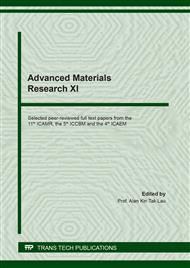[1]
Wang XY, Lee HS. Effect of global warming on the proportional design of low CO2 slag-blended concrete. Construction and Building Materials 225 (2019) 1140–1151.
DOI: 10.1016/j.conbuildmat.2019.07.134
Google Scholar
[2]
Wang XY. Simulation for optimal mixture design of low-CO2 high-volume fly ash concrete considering climate change and CO2 uptake. Cement and Concrete Composites 104 (2019) 103408.
DOI: 10.1016/j.cemconcomp.2019.103408
Google Scholar
[3]
Yan KZ, Shi CJ. Prediction of elastic modulus of normal and high strength concrete by support vector machine. Construction and Building Materials 24 (2010) 1479–1485.
DOI: 10.1016/j.conbuildmat.2010.01.006
Google Scholar
[4]
Xu JC, Ren QW, Shen ZZ. Prediction of the strength of concrete radiation shielding based on LS-SVM. Annals of Nuclear Energy 85 (2015) 296–300.
DOI: 10.1016/j.anucene.2015.05.030
Google Scholar
[5]
Abd AM, Abd SM. Modelling the strength of lightweight foamed concrete using support vector machine (SVM). Case Studies in Construction Materials 6 (2017) 8–15.
DOI: 10.1016/j.cscm.2016.11.002
Google Scholar
[6]
Yuvaraj P, Murthy AR, Iyer NR, Sekar SK, Samui P. Support vector regression based models to predict fracture characteristics of high strength and ultra high strength concrete beams. Engineering Fracture Mechanics 98 (2013) 29–43.
DOI: 10.1016/j.engfracmech.2012.11.014
Google Scholar
[7]
Yan KZ, Xu HB, Shen GH, Liu P. Prediction of Splitting Tensile Strength from Cylinder Compressive Strength of Concrete by Support Vector Machine. Advances in Materials Science and Engineering. Volume 2013, Article ID 597257, 13 pages.
DOI: 10.1155/2013/597257
Google Scholar
[8]
Behnood A, Verian KP, Gharehveran MM. Evaluation of the splitting tensile strength in plain and steel fiber-reinforced concrete based on the compressive strength. Construction and Building Materials 98 (2015) 519–529.
DOI: 10.1016/j.conbuildmat.2015.08.124
Google Scholar
[9]
www.mathworks.com.
Google Scholar
[10]
Ling Qin, Xiaojian Gao, Anshuang Su, QiyanLi. Effect of carbonation curing on sulfate resistance of cement-coal gangue paste. Journal of Cleaner Production 278(2021)123897.
DOI: 10.1016/j.jclepro.2020.123897
Google Scholar
[11]
Z. Mo, X. Gao and A. Su, Mechanical performances and microstructures of metakaolin contained UHPC matrix under steam curing conditions, Construction and Building Materials, https://doi.org/10.1016/j.conbuildmat.2020.121112.
DOI: 10.1016/j.conbuildmat.2020.121112
Google Scholar
[12]
Wang XY. Impact of Climate Change on Proportional Design of Fly-Ash-Blended Low-CO2 Concrete. ACI Materials Journal 116(2019) 141-151.
DOI: 10.14359/51714465
Google Scholar


